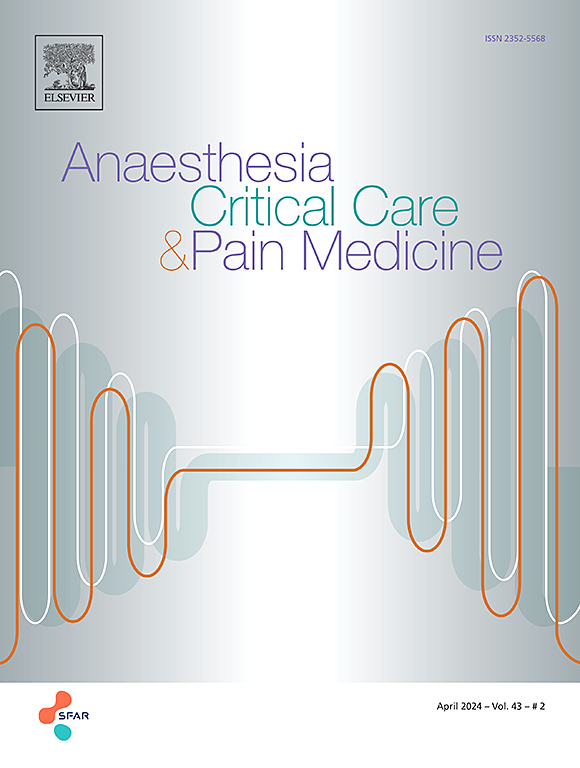Use of norepinephrine for intraoperative hypotension in pediatric anesthesia: a French survey
IF 4.7
3区 医学
Q1 ANESTHESIOLOGY
引用次数: 0
Abstract
Introduction
Intraoperative hypotension (IOH) is a common complication in the operating room. Vasopressors are crucial in managing IOH but data on their use in children, particularly norepinephrine (NE), are limited. This study aimed to explore NE use in IOH management among French pediatric anesthesiologists.
Materials and methods
A survey was conducted using an online Google Forms® questionnaire, validated by experienced pediatric anesthesiologists and the ADARPEF board. Distributed via the ADARPEF Research Network, the survey covered demographics, IOH definitions, treatment approaches, and NE use.
Results
We received 205 responses (44.1%). IOH was defined as a percent of fall of preoperative arterial pressure for 63.9% of respondents and normogram or age-based formulae value for 33.6%. Cerebral NIRS and invasive arterial blood pressure were the most common tools for monitoring patients with high risk of IOH. For vasoplegia-induced IOH, the first-line treatment was fluid bolus (49.2%) or ephedrine (35.3%). NE was used as second line treatment by 26.2 % of respondents. For IOH due to blood loss, fluid bolus was the primary treatment followed by NE. NE was used monthly by 79.3% of respondents and weekly by 45.3%. Variations in dilution and dosage practices were noted, with 70.5% reporting the use of highly diluted NE. Side effects were reported by 86.1% of NE users.
Conclusion
The survey highlights significant variability to determine the threshold of IOH requiring treatment and vasopressors use. NE is widely used by pediatric anesthesiologists, but practices vary, indicating the need for standardised guidelines and further safety studies.
去甲肾上腺素用于小儿麻醉术中低血压:一项法国调查。
术中低血压(IOH)是手术室常见的并发症。血管加压药在治疗IOH中至关重要,但关于儿童使用血管加压药的数据,特别是去甲肾上腺素(NE)的数据有限。本研究旨在探讨法国儿科麻醉师在IOH管理中使用NE的情况。材料和方法:使用在线谷歌Forms®问卷进行调查,并由经验丰富的儿科麻醉师和ADARPEF委员会验证。该调查通过ADARPEF研究网络发布,涵盖人口统计学、IOH定义、治疗方法和NE使用。结果:共收到应答205例(44.1%)。63.9%的应答者将IOH定义为术前动脉压下降的百分比,33.6%的应答者定义为正态图或基于年龄的公式值。脑NIRS和有创动脉血压是监测IOH高风险患者最常用的工具。对于血管截瘫引起的IOH,一线治疗是液体丸(49.2%)或麻黄碱(35.3%)。26.2%的应答者将NE作为二线治疗。对于失血引起的IOH,液体丸是主要的治疗方法,其次是NE。79.3%的受访者每月使用NE, 45.3%的受访者每周使用NE。注意到稀释度和剂量做法的变化,70.5%的人报告使用高度稀释的NE。86.1%的NE使用者报告了副作用。结论:该调查强调了确定IOH需要治疗和使用血管加压药物的阈值的显著变异性。小儿麻醉师广泛使用NE,但实践各不相同,这表明需要标准化的指南和进一步的安全性研究。
本文章由计算机程序翻译,如有差异,请以英文原文为准。
求助全文
约1分钟内获得全文
求助全文
来源期刊

Anaesthesia Critical Care & Pain Medicine
ANESTHESIOLOGY-
CiteScore
6.70
自引率
5.50%
发文量
150
审稿时长
18 days
期刊介绍:
Anaesthesia, Critical Care & Pain Medicine (formerly Annales Françaises d''Anesthésie et de Réanimation) publishes in English the highest quality original material, both scientific and clinical, on all aspects of anaesthesia, critical care & pain medicine.
 求助内容:
求助内容: 应助结果提醒方式:
应助结果提醒方式:


